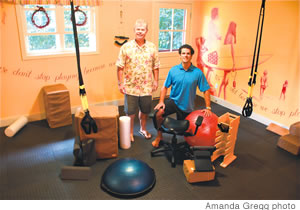The Best Of East,West

The father-son Dillberg team blends Western and Eastern medicine in their Poipu clinic
Dr. Kerry And Dustin Dillberg
Dillberg Integrated Healthcare
Introducing Dr. Kerry L. Dillberg, D.C., L.Ac, FASBE, D.C., L.Ac, FASBE, and Dustin Dillberg, L.Ac, PAS, of Dillberg Integrated Healthcare in Po’ipu. The father-son duo offers a holistic approach to traditional Chinese medicine, neuro-emotional techniques to health, sports therapy and postural integration chiropractics. The Dillbergs run a family business on the South Side, on a five-acre plot of land that spans the family’s generations of keiki to kupuna, just as Dr. Kerry Dillberg dreamed for himself since the tender age of 5.
You’ve had the idea in mind for a family practice since a very young age. Can you tell me how your dream came to fruition?
Dr. Kerry L. Dillberg: I unfortunately had a very difficult childhood, and I had a driving desire for a family of my own. I was living with an aunt and uncle, and (my wife), who I met when I was 4, was literally the girl next door. I proposed at a very young age, 12. People thought we were crazy. But for me, I wanted to start a life and get things going. I wanted a piece of land and wanted us to all live together. Now we have a five-acre parcel, three kids and eight grandkids and we all live on the property.
When did you know you wanted to pursue a degree in chiropractic medicine?
KD : At the age of 5 I wanted to be a doctor. I wrote several letters to several schools. I was dead serious about it.
Where did you receive your training and schooling?
KD: I studied at the Cleveland Chiropractic College’s Los Angeles campus and traditional Chinese medicine for four years at SAMRA University. (Both my son and I) also studied with Dr. Robert Bradford with American Biologics and with Burl Pettibon with Pettibon Spinal Technologies.
Dustin Dillberg: I earned a master’s degree from the Pacific College of Oriental Medicine in San Diego, Calif., and I continued my studies with exercise therapy and postural work at the Egoscue University. I’m also now working as an instructor online and doing in-person seminars.
What separates your practice from others?
KD: Our holistic model. The brain controls and coordinates everything. From a research standpoint, in holistic circles, the argument is that there is a four-tiered model. Those four categories are physical stresses, chemical stresses, emotional stresses and electromagnetic- or energy-field stresses. So we make the point that a truly integrated and holistic practice is going to be able to measure or quantify what is going on with an individual within those four categories.
How would you define physical stresses?
KD: Physical stresses begin being analyzed and quantified with developmental process in the womb and go on through the traumas of birth, learning to crawl, walk, falling off that first swing, and continue through sports injuries and on through life.
The most significant concern with physical stresses is going to affect postural alignment. So whatever alignment someone is in, good or bad, it is influenced or controlled by the nervous system and is considered to be a direct reflection of how much physical stress the nervous system has had to absorb or compensate for.
What are some other ways you recommend patients keep healthy?
KD: Keeping emotional stress levels to a minimum. The primary way you do that is teaching people a specific procedure to see how their brain responds to negative stored memory patterns. Basically, in a nutshell, you should aim to find the good in any situation.
That can be a tough sell when you’re dealing with a quadriplegic. But the truth is, we all have a free choice in how we respond to stress. Everyone has stress in (his or her) lives. We have free choice of being loving, caring, forgiving, accepting and tolerant, or fearful, angry, covetous, worried and doubtful.
What are the pros of thinking positively, and the risks of thinking negatively?
KD: Whenever we choose to think positively, the studies show from a chemical standpoint there is a flood of alkaline material. It cools down. In fact, our brain is described as the greatest pharmacist ever discovered.
There are a number of alkaline agents that have been shown to be strong anti-cancer, anti-inflammatory qualities.
With negative thinking, our brain heats up and becomes orange and red on the graphs, and we get a flood of acidity. Our primary stress hormones cortisol and adrenaline, which are very acidic but vital to survival, tax the immune system, we become exhausted and we prematurely age, rot and decay.
What are some preventatives to degenerative disease that you recommend?
DD: One way to prevent disease is to eat a high-alkaline, low-acid diet. Another way is, the more movement, the better: No couch potatoes. Pain is a communication from the body to let you know what is going on. Getting people moving is a constant report card.
What are some examples of alkaline and acidic foods?
KD: Primarily fruits and veggies are alkalizing foods. We jokingly call the acid category nuts, seeds, grains, candy and ice cream.
What age group do you mostly treat?
KD: Infants to geriatrics.
What is Egoscue medicine?
DD: It is a posture-focused, therapeutic- exercise program. It differs from physical therapy in that it’s not focused on the symptom.
Where can readers learn more about your practice?
Our website is www.dillberghealth.com
You must be logged in to post a comment.




There are no comments
Add yours